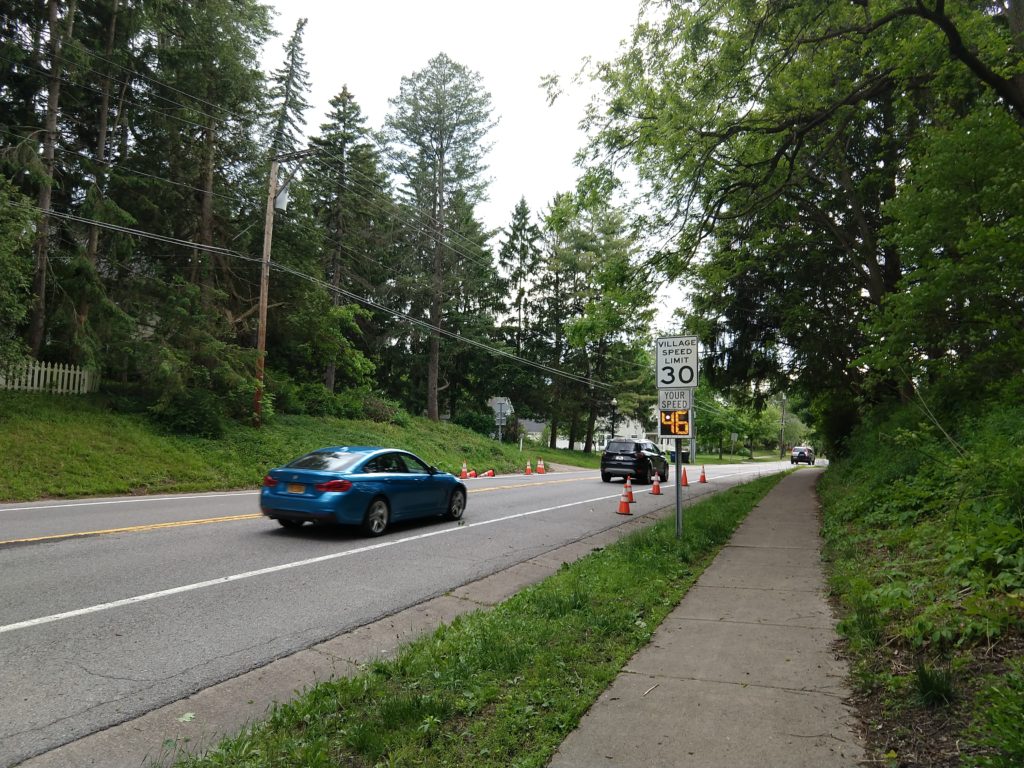The Village of Pittsford recently installed a temporary speed sentry – a radar speed display for traffic – in both directions along State Street from the Village line to State Street Bridge due to years of resident concerns. Residents have raised the issue of speeding for years, and as COVID-19 reduced the number of cars on the road, drivers seemed to be speeding even more. The speed sentry is capable of recording speed data, and we share some takeaways below.

Speeding is has been a chronic issue on our village streets for years. We provided an overview of the impact speed has on safety and livability in 2017, and recently looked at State Street and our arterials entering the Village in particular in. At that time, we suggested some actions, including lowering the speed limit in the Town approaching the Village to 35mph and getting legislation passed by the State to allow the village to make its streets 25mph, which we stand by. Adopting the Active Transportation Plan, redesigning our gateways, and redesigning roads when resurfacing and engineering projects arise also need to be on the table.
The speed sentry was placed at the village boundary in both the eastbound and westbound directions. 24,000-25,000 vehicles travel State St in each direction per week.
Westbound, the speed limit in Town is 45mph and drops to 30mph in the Village. State Street residents’ experience is that drivers don’t slow down until at least State Street Bridge/Schoen Place, and usually further on into the village around Boughton Ave.
Westbound traffic clocked in with 10% driving the speed limit or under, and a full 90% exceeding the speed limit. These numbers include residents’ pulling in and out of their driveways at low speeds, so numbers seem to indicate most—almost all—drivers are exceeding the speed limit entering the village.
| Miles Per Hour | 1 – 10 | 11 – 20 | 21 -30 | 31 – 40 | 41 – 50 | 51 – 60 | 61 – 70 | 71 – 80 | 81 – 90 | 91 – 100 | Total Vehicles |
| Westbound Total | 84 | 348 | 1,976 | 11,709 | 10,406 | 400 | 6 | – | – | – | 24,929 |
| Westbound % | 0.3 | 1.4 | 7.9 | 47.0 | 41.7 | 1.6 | 0.0 | 0.0 | 0.0 | 0.0 |
This same pattern of speeding on Village arterial streets is seen at all the Village gateways. We hear the same concerns from residents on S. and N. Main Street, E. and W. Jefferson Ave, Monroe Ave, and Washington Rd, in addition to State St.
On eastbound State St, the speed limit is 30mph, but the hill from State St Bridge out of town combined with a wide, open road, leads to drivers speeding up leaving the village.
Eastbound traffic showed 68% of the traffic exceeding the speed limit and 32% driving at or below the speed limit, again also including residents’ pulling into/out of their own driveways.
| Miles Per Hour | 1 – 10 | 11 – 20 | 21 – 30 | 31 – 40 | 41 – 50 | 51 – 60 | 61 – 70 | 71 – 80 | 81 – 90 | 91 – 100 | Total Vehicles |
| Eastbound Total | 69 | 957 | 6,654 | 15,657 | 569 | 27 | 3 | 1 | – | – | 23,937 |
| Eastbound % | 0.3 | 4.0 | 27.8 | 65.4 | 2.4 | 0.1 | 0.0 | 0.0 | 0.0 | 0.0 |
We realize this data is only captured in 10 mph increments, and doesn’t show the nuance between 31mph and 39 mph. So we don’t have the full picture. 31 mph is different than 39mph.
But we know that our human bodies made up of bones and tissue will never be a match for a vehicle going at 31mph, and at 39mph, even less so. At 30mph, 50% of people will survive that crash—only half. At 40mph, 10% of people will survive that crash. That number is frighteningly small.
There were two speeds recorded Eastbound in the 71-80mph range, and three in the 61-70mph range during this week of data collected. Westbound, there were six in the 61-70mph range. We think these could partially be accounted for by emergency vehicles, but we don’t know for certain. It’s a scary high speed for a residential street.
The speeding problem persists all day and all night; there is no one time when the numbers are bad. And it’s a problem that will require a multi-pronged approach of road re-design, lower speed limits, and enforcement of those limits. It requires bringing together large bureaucracies that have conflicting interests. And it requires everyone realizing that people are walking, biking, playing, sitting on their porches, selling lemonade, trying to cross to a neighbor’s house, and living on these streets, and that the margin for error is small at these high speeds.
